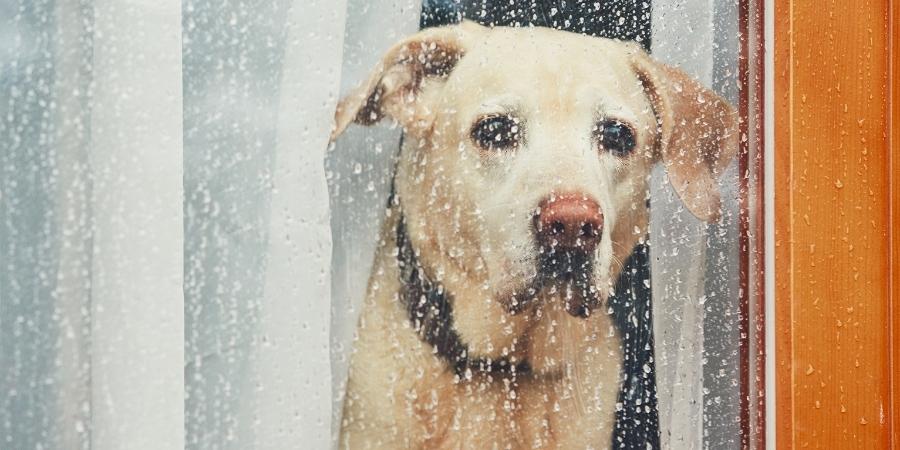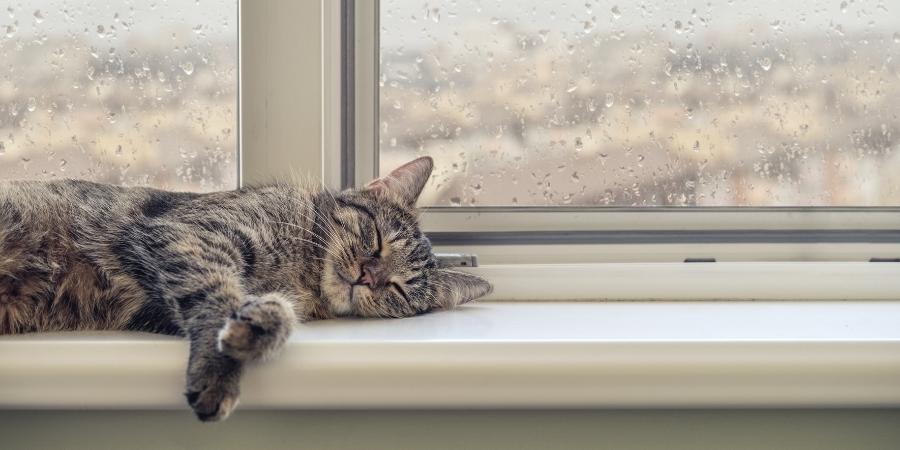But, as we know, the Great British weather is often unpredictable and stormy weather can happen at any time of the year, so it’s a good idea for pet owners to always be prepared. Strong winds, loud noises, and unexpected flashes of light can scare any pet, so it’s important to know how to keep your furry friend safe, happy, and healthy should the weather take a turn. Remember, pets cannot protect themselves, so it’s our responsibility to ensure their safety.
Here are some of our top tips to keep dogs, cats, and small pets safe during stormy weather:
Dogs

- Keep an eye on the weather forecast when planning your walkies together - your dog might be happier going on a few short walks rather than one long walk where you both might get soaked and cold. If any extreme weather warnings are in place that day, you should skip the walk and remain indoors with your pet.
- As heavy rain clouds begin to form, the sky becomes darker and overall outdoor visibility worsens. To ensure your pet’s safety, use a reflective lead and collar, so they remain seen at all times.
Shop our range of reflective and flashing pet accessories
- Sudden loud noises can spook dogs and sometimes cause them to panic and run away. Always ensure your dog wears a collar with an ID tag on it in case they manage to escape. You should also check that their microchip details are up to date too.
- Before a storm starts, close all windows and curtains, so any unsettling sounds and sights from outside are hidden. To further drown out any loud noises, play some music or put the TV on in the room your pet is in.
- Puzzle toys or toys stuffed with a tasty dog-safe treat are great for keeping your four-legged friend distracted during bad weather. Just be mindful of any additional calories!
- Should your dog prefer to hide away during a storm, a dedicated doggy den filled with cosy blankets will offer a safe space for them to settle. If your dog has a crate, you should always keep the door open, so they don’t feel trapped.
- Avoid leaving your dog unsupervised during stormy weather, as being alone could heighten their anxiety. Give them plenty of reassurance if they want it from you, to let them know you’re close by and there’s no real danger.
Cats

- If your cat likes to spend lots of time exploring outside, make sure they’re always able to come back into your home, so a sudden downpour of rain doesn’t catch them out. Check that your cat’s microchip details are up to date in case your cat panics during a storm and gets lost.
- If you know a storm is coming, it’s a good idea to keep your feline friend indoors by locking the cat flaps and shutting all windows and doors. Make sure you have a litter tray available, even if your cat doesn’t usually use one, so they have a place to toilet if they’re indoors.
- Again, keep all windows and curtains shut so that your cat isn’t fully exposed to the storm. Have other sounds playing in the background to help reduce the outside noise.
- Similarly to some dogs, cats may need a safe space for those times when they want to hide away. They often feel secure when high up; on top of a shelf or a cupboard is usually their preferred spot. To help prevent any injuries, keep a close eye and ensure they can get up and down from this spot easily.
- If your cat is showing signs of stress or anxiety because of the bad weather (e.g. scratching, hiding, or yowling), pheromone diffusers can help to make them feel more comfortable and relaxed.
Small pets
- Severe weather can be particularly dangerous for small pets who live in the garden, such as rabbits and guinea pigs. To keep them sheltered from the heavy storms, temporarily move their hutch into a well-ventilated, enclosed outbuilding (e.g. a car-free garage or shed) or bring them inside your home.
- Hutches can quickly become soggy and uncomfortable if they aren’t adequately protected from the rain. To keep your small pet dry, their hutch should be raised off the ground and have a sloped roof to allow rainwater to drain away.
- Cover their run and/or hutch with thick blankets, so they feel more secure, ensuring there is still good ventilation. It’s also a good idea to give them extra bedding for warmth and other places for them to hide, such as cardboard boxes or tunnels.
What to do if you need to evacuate
Though it’s rare, you may be asked to leave your home for safety reasons if the weather becomes life-threatening. This, of course, can be really distressing for you and your pet.
Here’s what you can do to make evacuation safe for you both:
- Carefully place cats and small pets in their own secure pet carrier so you can transport them safely. In the interest of time, it’s a good idea to learn all their favourite hiding spots, so you can find them quickly.
- Dogs should wear a well-fitting collar and ID tag with up-to-date contact details at all times and remain on a secure lead.
- If you have time to pack, think about the essential items you’ll need to care for your pet in the short-term (e.g. their food, blankets, and any medications they may take).
- If you’re asked to leave your home without your pets, secure them inside a room upstairs and make sure they have access to plenty of fresh water and food. As soon as you’re safe, you should let the rescue services know where your pet is so they can reunite you as soon as possible.
